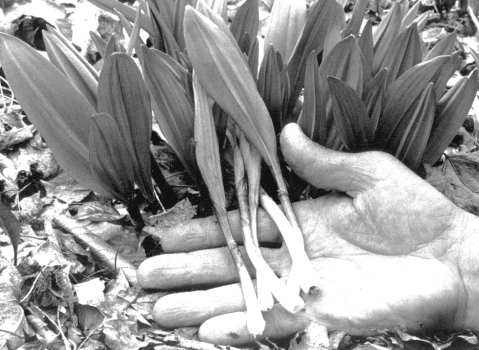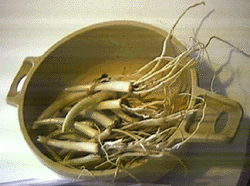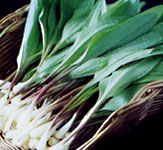
Ramps are delicious delicacies that grow in the mountains of Yancey County and surrounding areas. "Ramp Season" is usually from April to May. I would have to say, "Ramps" are one of my favorite foods. Here are some facts and history I found out about "Ramps" on the web. If you have never eaten Ramps, you can purchase from Earthy Delights or if you have relatives in Yancey County, have them dig some for you. One of my favorite places to dig Ramps was on Bald Mountain up above the old Buck House. After getting to the "ramp patch", I liked to just sit down and eat a few of them raw. These things are delicious, but be warned, if you eat them raw you will have a very strong distinct odor about you for a couple of days. Try them cooked and the odor isn't so bad, see favorite recipes at the bottom of the page and also see the "Ramp" tee shirts for sale.
![]()

There is a happening taking place fit for a king. Like the front row of trombones in a marching band blaring the oncoming joyous spirit of some important event, the wild leeks are announcing the arrival of spring in the woods.
Mountain people of the Southeast have honored these savory plants, which they call ramps, for many years and celebrate the occasion of their emergence with eagerly-awaited festivals. This pungent vernal greenery is their spring tonic. Winter has passed and now the people will begin their own planting prompted by the arrival of the first vegetable in natureís garden.
The use of leeks dates at least as far back as the Egyptians and the time of the Pharaohs. The Holy Bible, Numbers 11:5, states, "We remember the fish, which we did eat in Egypt freely; the cucumbers, and the melons, and the leeks, and the onions, and the garlic:"
Apparently their plants were somewhat similar to the cultivated leeks available through many seed catalogs today. They too have escaped into the wild and become naturalized in some of the eastern states.
All leeks, native or otherwise, are generally alike. They belong to the large lily family, containing about 325 species, and are close relatives of the onion, garlic, shallot and chives. Their genus, Allium, is Latin for garlic. Indeed, I have always felt that the flavor of leeks is considerably more like that of garlic than onion.
Twelve species of Allium are listed in Grayís manual of Botany. Four of them are wild garlic, five wild onion, two leek (one being the naturalized plant from southeastern Europe), and one chives.
Other native wildflowers of this region related to the leeks, and often growing in the same woods, are wood lily, bellwort, trout lily, asparagus, clintonia, Canada mayflower, Solomonís-seal, twisted stalk and trillium.
The rolled-up, quill-alike foliage of young leeks quickly develops into flat, rubbery, rich green leaves that can get to be two or more inches wide and eight or nine inches long. Frequently they will occur in patches of hundreds, or even thousands, of plants growing in rich soil of maple-beech-hemlock hardwoods. In case you are in doubt as to the plantís identity, trust your nose for positive verification. There can be no mistake. Many people claim the odor and taste are a pleasant combination of onion and garlic.
The leaves, like typical ephemerals, appear rapidly in early spring and survive for a relatively shore duration. They wilt and disappear quickly once the dense forest canopy of broad leaves has formed. The bulbs will naturally persist much like young onions or scallions, the base somewhat swollen but without a true bulb. In fact some of the mountain people call them rampscallions.
Flowers are borne in the summer on a thin nine or ten-inch-tall stem. The quarter-inch greenish-white florets radiate from a central point and resemble a typical rounded cluster of onion flowers, although much smaller. By fall the flowers give way to tiny steely blue-black buckshot-like seeds, each at the end of its half-inch-long stem. Dig the leek up during the fall color season and you will find the bulb to be the size of your thumb.
This column appeared in the Door County Advocate on 03/31/2000.


The ramp (Allium tricoccum), or wild leek, belongs to the same pungent genus as onions (A.cepa), chives (A. schoenoprasum), and garlic (A. sativum), not to mention the showy ornamentals such as A. giganteum, with its massive purple pompon head. The ramp's odor is something akin to that of garlic and onion, but distinguishes itself by its persistence and its occasionally musty flavor.
Ramps are native to eastern North America, ranging from the rich, moist woodlands of Nova Scotia and southern Quebec, south through New England and the central Appalachian states, down into the cool upland portions of Georgia, and as far west as Iowa and Minnesota.
What's in a name
The Appalachian name "ramp" comes from the British Isles, where a
related plant, A.ursinum, grows wild. As one version has it, the
English folk name "ramson" (son of Ram), referred to the plant's
habit of appearing during the sign of Aries; March 20 to April
20; on the zodiac calendar. Another source indicates that the folk
name was "ramsen," the plural form of an Old English word for wild
garlic, "hramsa." The similarity between A. ursinum and A.
tricoccum in taste, appearance, and growth habit led early English
settlers of Appalachia to call the latter by the English folk name, which
later was shortened to "ramp."
Native medicine
To early Native American and, later, the white settlers, ramps were an
important and welcome addition to the early spring menu. The fresh and
tender-green ramp leaves with their strong onion-garlic taste were an
improvement on the bland winter fare of dried fruits, pickled vegetables,
nuts, beans, and dried beef or salt pork; they were regarded as a spring tonic
that cleansed the blood.
Modern science supports this folk tradition. Alliums are a good source of Vitamin C, a fleeting nutrient that was often lacking in winter diets, as well as prostaglandin A1, a fatty acid known to be therapeutic in the treatment of hypertension. Studies have linked the genus to increases in the production of high-density lipoproteins, which in turn are believed to combat heart disease by reducing blood serum levels of cholesterol. So, by following their instincts and taste buds, these early mountain folk discovered a valuable nutritional supplement.
Native Americans knew ramps well. They used them in decoctions to treat coughs and colds, and they made a poultice from the juice of the strong summer bulbs to alleviate the pain and itching of bee stings. The Menomini called them pikwute sikakushia (skunk plant), and they referred to an area near the southern shore of Lake Michigan, where ramps grew abundantly, as CicagaWuni or shikako (skunk place). The term was later applied to a white settlement now known as Chicago.
The late wild foods evangelist Euell Gibbons considered ramps "the sweetest and the best of the wild onions. They have a mild onion flavor with a hint of garlic, which I find delicious." The mildness is relative, however. Though definitely more delicate than the typical wild onion or garlic, ramp greens are decidedly more pronounced and lingering in flavor (though less hot) than ordinary cooking onions.
Now that modern technology has given us a steady, year-round supply of fresh fruit and vegetables, our dietary need for ramps as a spring tonic has diminished. But to mountain folk, especially those in central West Virginia and western North Carolina where the tradition still lingers, the social medicine conferred by ramps is an integral rite of spring, a spiritual need.
How the ramp doeth grow
In late winter or very early spring, each bulb sends up two or three broad,
smooth, ovate leaves--similar to those of lily-of-the-valley--from the leaf
litter on the forest floor. Eventually growing 8 to 12 inches tall, these
leaves show deep maroon streaking at the base and up along the parallel veins.
Ramps reproduce by both bulb offsets and seeds, and large colonies can blanket
a hillside.
By late spring or early summer, as the tall canopy of trees leafs out and begins to shade the ground, the ramp's leaves wither and die, leaving only a single bud on a naked stalk. This bud opens in June or July to form a spherical cluster (umbel) of creamy white florets. Each quarter-inch flower has three sepals and three petals and produces a three-lobed seed capsule. After the ramp has finished blooming, it goes into dormancy, which lasts through the driest, hottest days of summer, fall, and the worst of winter's cold, recommencing its activity as the weather begins to moderate in March or April.
*Article written in part by M.J. McCormick for Herb Companion; March 1991.
![]()
Favorite Ramp Recipes
iron skillet
| 4 or 5 large potatoes, diced
| 1 lb. bacon
| 1 1/2 lb. ramps, cleaned and cut up
| 6 eggs (optional)
| salt and pepper to taste | |
- Fry bacon in skillet.
- Remove from pan and set aside.
- Put cut up potatoes in bacon grease and let fry 3 to 4 minutes.
- Add cut up ramps and continue frying until potatoes are well done.
- Put previously fried bacon on top of potatoes and ramps; let simmer for
about 2 minutes.
If you want to add scrambled eggs, add after potatoes are done and before adding bacon.
1 lb. pork sausage
| 4 eggs
| 2 c. grated Cheddar cheese
| 2 c. milk
| 15 ramps
| 10 potatoes, sliced | |
- In skillet fry sausage, stirring as it fries.
- Beat eggs, add milk and set aside.
- In large baking dish, layer potatoes, sausage and chopped ramps.
- Pour egg and milk over mixture over layers.
- Top with grated cheese.
- Bake at 350 degrees until potatoes are tender.
strips streaked meat
| 4 medium potatoes
| 12 ramps, chopped
| 8 eggs | |
- Fry meat until all grease is rendered.
- Remove meat.
- Fry very thin sliced potatoes in grease until done.
- Add ramps; cook 2 minutes over medium heat.
- Mixing well while frying.
- Pour eggs over potatoes and ramps.
- Stir until egg are done.
Makes 4 servings
![]()
Ramp Tee Shirt designed by local artist Patrick Bradford. Everyone (almost) in the mountains and our great visitors know and love RAMPS! Now let the world know that you love them with this great full color tee shirt. Only $15.00 plus $3.00 shipping and handling outside of Burnsville, NC. Just specify size in adult or kids shirts.

To order:
Send check or money order to:
Patrick Bradford
121 Dale Earnhardt Drive
Burnsville, NC 28714
Email for more details if needed: Patrick
Bradford
![]()
| Last Updated 03/26/2017 09:44 AM by Rick Silvers | contact me: rsilvers@mebtel.net |